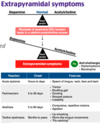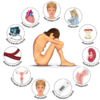psychiatry - mood disorders and psychoses Flashcards
example of mood disorder
mood disoder
how can mood disorder affect pt
May present to the dentist (RARE)
- Oral effects (somatiform disorders)
- Dysaesthesias
- Facial pain
Patient’s general demeanor – particular if familiar with pt/staff
should you tx pt during period of depression?
any important decision – extraction, appearance etc – may be better to delay if pt not in best reflection on themself
mood disorder spectrum
Change depend on circumstances (environment and within ourselves)
- Cyclothmia – normal mood swing
Different severities of depression – most not psychotic (still have contact with environment - neuroses)
- At extremes of depression, psychoses can take over and pt have a psychotic view on world/reality
Depressive disorder can persist for some time or return to normal mood (be recurrent depressive disorder)

cyclothemia
normal mood swing

unipolar disorder
moves only in one direction on mood spectrum
(usually low mood)

bipolar affective disorder
moves in both directions

natural changes in mood progression
Normal mood swings
Cyclothymic
- Temperament - quite common
- Disorder –exaggerated mood swings
Bipolar type II
- more depressed – never reach mania
Monopolar mania
- does span into depression, just normal to mania
Bipolar type I a.k.a true
- range from mania with psychosis to depression with psychosis (returning to euthymic state)

two classess oc cychlothymic issues
- Temperament - quite common
- Disorder –exaggerated mood swings

bipolar type II
more depressed – never reach mania

monopolar mania
does span into depression, just normal to mania

bipolar type I
true
range from mania with psychosis to depression with psychosis (returning to euthymic state)

mood disorders prevalance
common
Female: Male
2-3 : 1
unipolar point prevalence
6%
bipolar life prevalence
1.2%
puerperal mood disorder a.k.a
post natal depression
prevalence of puerpral mood disorder
0.5/1000 in one month
1/1000 in one year
Prone to have with next pregnancy if had already
effect of puerperal mood disorder
inability to enjoy the moment - thinking of months and years ahead with baby
Prone to have with next pregnancy if had already
common types of depressive disorders (7)
- major depressive disorder
- persistent depressive disorder
- bipolar depression
- postpartum depression
- premenstrual dysphoric disorder
- seasonal affective disorder
- atypical depression

major depression disorder
extent
can reach severe and psychotic depression
persistent depression disorder
extent
pt runs at low mood, never returning to normal or reaching depths of depression
10 common symptoms of depression
- Low mood
- Reduced interest and motivation – in people and environment
- inc things that used to be enjoyable for them
- Lethargy and tiredness
- Sleep disturbance
- Appetite disturbance – eat excessively or lose all interest in food
- Poor concentration
- Loss of confidence and self esteem
- Recurrent thoughts of death and suicide
- pt may not want to carry them out – scary for them
- Ask if they have thought about how to carry out
- pt may not want to carry them out – scary for them
- Unreasonable self-reproach and guilt
- Any form of anxiety
clinical criteria for major depressive disorder
5 or more with depressed mood and interest loss, for at least 2 weeks

S sleep changes
I interest loss (anhedonia
G guilt (worthless)
E energy lack
C concentration reduced
A appetite change
P psychomotor change
S sucidide ideation/thoughta
2 types of bipolar on bipolar spectrum
Bipolar 1
- Mania – normal to high mood
Bipolar 2
- Cyclothymia, Hypomania (with psychosis) and then down into depressive state
















